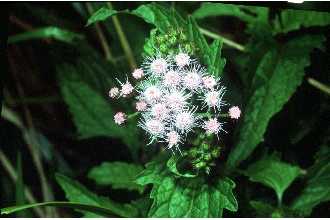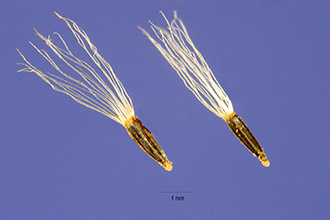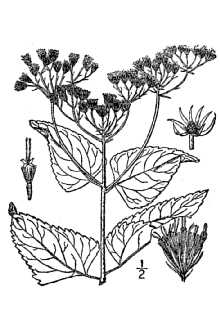Eupatorium coelestinum L.
Scientific Name: Eupatorium coelestinum L.

| General Information | |
|---|---|
| Usda Symbol | EUCO6 |
| Group | Dicot |
| Life Cycle | Perennial |
| Growth Habits | Forb/herb |
| Native Locations | EUCO6 |
Plant Guide
Use soil moisture sensors to measure the soil moisture of Eupatorium coelestinum L..
Fact Sheet
Alternate Names
Eupatorium coelestinum L., wild ageratum
Uses
This plant is used mainly for landscape beautification. It has potential for use in cultivated, garden situations, in naturalized prairie or meadow plantings, and along roadsides.
Status
Please consult the PLANTS Web site and your State Department of Natural Resources for this plant’s current status (e.g. threatened or endangered species, state noxious status, and wetland indicator values).
Weediness
This plant may become weedy or invasive in some regions or habitats and may displace desirable vegetation if not properly managed. Please consult with your local NRCS Field Office, Cooperative Extension Service office, or state natural resource or agriculture department regarding its status and use. Weed information is also available from the PLANTS Web site at plants.usda.gov.
Description
Sunflower Family (Asteraceae). Mistflower is an erect (to 3 feet), rhizomatous perennial, often forming colonies. It is a U.S. native. The opposite leaves are oval-shaped, hairy, and have toothed edges. The small flower heads are clustered at the top of the plant. They are powder blue to violet and fluffy in appearance, similar to Ageratums used as garden bedding plants. The tiny seeds are black, elongated, and have long white hairs attached to one end. © William S. Justice Smithsonian Institution @ USDA NRCS PLANTS
Adaptation and Distribution
Distribution
Distribution
Mistflower is adapted to most soil types, but is especially suited to heavy textured and to highly organic soils. Natural stands are found on moist to wet sites, such as low woods, wet meadows, and ditches. It grows best in full sun, but will tolerate light shade. Blue mistflower is distributed throughout the eastern and midwest United States. For a current distribution map, please consult the Plant Profile page for this species on the PLANTS Website.
Establishment
A clean, firm seedbed is essential, Use soil moisture sensors to measure the soil moisture of Eupatorium coelestinum L.., The site should be treated with a herbicide to control existing vegetation, tilled, cultipacked once or twice, and allowed to settle thoroughly before sowing, Broadcast ½ to ¾ gram seed per 100 square feet (½ to ¾ lb/acre), Bulk sowing rates usually need to be increased to allow for low purity values, The seed can be mixed with sand or rice hulls to increase volume so that it will be easier to spread uniformly over the planting site, Seed must remain on the soil surface because they are easily smothered when buried in the soil, The seed will not germinate until the following spring, but will benefit from the cool, moist winter environment,
Management
Apply fertilizer according to soil test recommendations. If not available, a rate of 3½ to 5½ oz/100 square feet (100 to 150 lbs/acre) of 13-13-13 should be applied after the seedlings are established and annually thereafter. Stands can be mowed in the spring and early summer. Later mowings should be delayed until the plants have set seed.
Plant Traits
Growth Requirements
| Temperature, Minimum (°F) | -13 |
|---|---|
| Adapted to Coarse Textured Soils | No |
| Adapted to Fine Textured Soils | Yes |
| Adapted to Medium Textured Soils | Yes |
| Anaerobic Tolerance | Low |
| CaCO3 Tolerance | Medium |
| Cold Stratification Required | No |
| Drought Tolerance | Medium |
| Fertility Requirement | Medium |
| Fire Tolerance | Low |
| Frost Free Days, Minimum | 170 |
| Hedge Tolerance | None |
| Moisture Use | Medium |
| pH, Maximum | 7.5 |
| pH, Minimum | 5.5 |
| Precipitation, Maximum | 60 |
| Precipitation, Minimum | 24 |
| Root Depth, Minimum (inches) | 14 |
| Salinity Tolerance | None |
| Shade Tolerance | Tolerant |
Morphology/Physiology
| After Harvest Regrowth Rate | Slow |
|---|---|
| Toxicity | None |
| Resprout Ability | No |
| Shape and Orientation | Erect |
| Active Growth Period | Summer |
| Bloat | None |
| Coppice Potential | No |
| Fall Conspicuous | Yes |
| Fire Resistant | No |
| Flower Color | Blue |
| Flower Conspicuous | No |
| Foliage Color | Green |
| Foliage Porosity Summer | Moderate |
| Foliage Porosity Winter | Moderate |
| Fruit/Seed Conspicuous | No |
| Growth Form | Single Crown |
| Growth Rate | Moderate |
| Height, Mature (feet) | 3.2 |
| Known Allelopath | No |
| Leaf Retention | No |
| Lifespan | Moderate |
| Low Growing Grass | No |
| Nitrogen Fixation | None |
| Foliage Texture | Medium |
Reproduction
| Propagated by Seed | Yes |
|---|---|
| Propagated by Sod | No |
| Propagated by Sprigs | Yes |
| Propagated by Tubers | No |
| Seed per Pound | 1500000 |
| Fruit/Seed Period End | Fall |
| Seed Spread Rate | Moderate |
| Seedling Vigor | Medium |
| Small Grain | No |
| Vegetative Spread Rate | None |
| Propagated by Corm | No |
| Propagated by Container | No |
| Propagated by Bulb | No |
| Propagated by Bare Root | No |
| Fruit/Seed Persistence | No |
| Fruit/Seed Period Begin | Summer |
| Fruit/Seed Abundance | Medium |
| Commercial Availability | Routinely Available |
| Bloom Period | Summer |
| Propagated by Cuttings | No |
Suitability/Use
| Veneer Product | No |
|---|---|
| Pulpwood Product | No |
| Post Product | No |
| Palatable Human | No |
| Palatable Graze Animal | Low |
| Nursery Stock Product | No |
| Naval Store Product | No |
| Lumber Product | No |
| Fodder Product | No |
| Christmas Tree Product | No |
| Berry/Nut/Seed Product | No |


